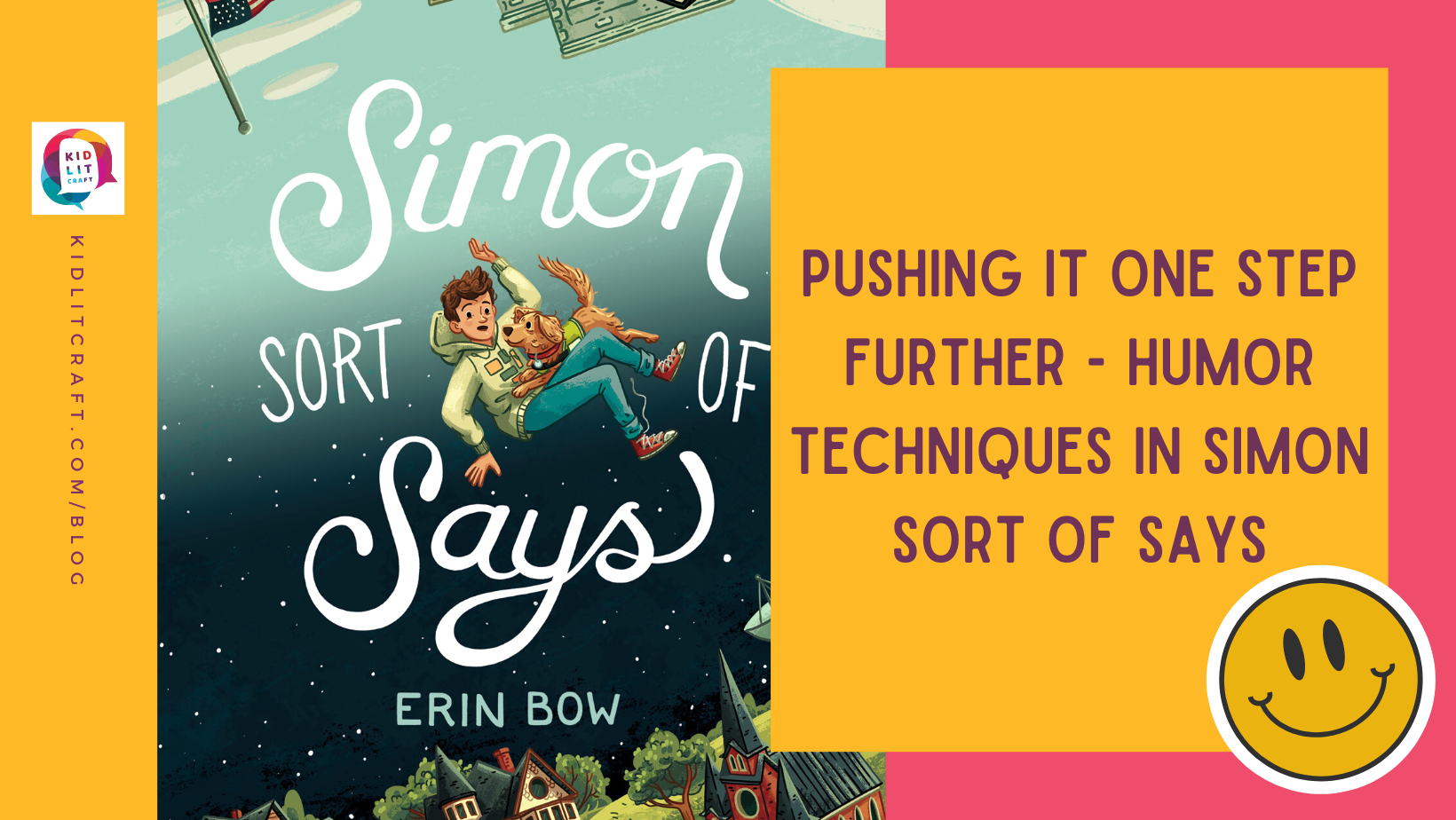craft review by Jackie Friedman Mighdoll
Simon Sort of Says is my new favorite middle grade novel, a laugh-aloud story about the sole survivor of a mass school shooting. Did I just put the words laugh aloud and school shooting in the same sentence? I did. And I meant it. This isn’t just a book with a kid with a snarky tone. Or a great voice. This is a book that’s so funny I snorted. My friend – a normal adult with no particular interest in books for 8-12 year olds – not only laughed aloud, but she made her husband, her college-age son, and her dog read it, too. I’m exaggerating. But only by a chihuahua.
Simon, the main character and first-person narrator, goes to live in a new town where there is no Internet access. He doesn’t want everyone to know about his past trauma. He’s hoping to make new friends. But there’s no evading the after-effects of a trauma.
Humor and warmth are the undercurrent of this book. Simon and his family deal with events with humor. Simon connects with new friends through jokes and laughter. Ultimately, their connections and their ability to keep laughing helps them in the healing process.
I examined Erin Bow’s masterpiece to see if I could identify techniques she uses to create humor. Here’s what I found.
1. Names
Naming is a prime opportunity for humor. The town in Simon Sort of Says is called Grin and Bear It. The funeral home Simon’s mom runs is Slaughter and Sons. The peacock is Pretty Stabby. On their own, the names are funny. But the author pushes it even further. Her narrator is aware of the ridiculousness of the names–and comments on them, making it that much funnier. They are jokes shared with the reader. For example, on the town name of Grin and Bear It, Simon says:
“First that name. It’s worse than Truth or Consequences, New Mexico or Come By Chance, Newfoundland, or even Intercourse, Pennsylvania. They call it GNB sometimes, but that doesn’t help.”
I’ve heard this described recently as ‘hanging a lantern.’ When you point out to the reader that this is something that you know sounds far-fetched, it becomes easier for the reader to accept.
2. Clever Language
I love clever language and word-play. While the foundation of the humor is in the unexpected situations, the language adds to it. The made-up words are clear and funny! The twelve-week old puppy has reached “ball-of-fuzz” cuteness. His tongue is “blepping” out. His dad smells of brass polish–“eau de sackbut.” (Sackbut really is an early trombone–and an instrument ripe for word-play jokes.
3. Layers that build
Bow layers the description and builds the humor with each additional outlandish layer:
“The goats have so much curly dirty gray fur that they look like Muppets with horns and noses. [layer 1]
Pink ears stick out from near the horns and two buckteeth stick out from beneath the nose. [layer 2]
They are milling around the farmyard while Agate’s little brother Onyx rides through them on a tricycle, [layer 3]
whacking them on their butts with a bit of rope and trying to yodel.” [layer 4]
Bow layers both the language and the situation.
Simon is scared when his mother, a funeral director, gets the call to go to his friend Amber’s farm. But Amber’s farm is overrun by emus.
“Emus not a death,” his mother says. “Not even dead emus, as far as I know.”
It’s not three emus, as Simon might have expected, but twenty!
4. Pushing the boundaries
Comedy is often about pushing boundaries or skirting the edge. And there are plenty of things in the book that skirt the middle-grade edge creating comedy. The dog, Tod, drinks beer for his hip dysplasia. A squirrel eats the sacrament at church and is dubbed “Jesus Squirrel.” Simon and his friends talk of spring-loaded duck penises, taped boobs, and farting corpses. The dad spells out s-h-i-t, to which Simon says, “Uh, Dad. You know I can spell now, right?”
(Of course, there’s a sad irony that we consider the boundary-pushing aspects of the middle grade book to be duck penises and swear words rather than the fact that the main character is the sole survivor of a mass school shooting….)
5. Funny repartee/dialogue
The book is humorous because Simon, the first person narrator and main character, is funny. But adding other characters with a sense of humor amps the humor, because it allows for funny dialogue and repartee. Simon’s parents are also funny. One of my favorite passages is an exchange between Simon’s mother and father. A squirrel has gotten into the tabernacle of the church where Simon’s father works. Simon is clarifying with his dad what happened.
“In the tabernacle, did he -”
“Eat the Host?” says Dad. “Yes, he did.”
“Was it -”
“Consecrated?” says Dad. “Yes, it was.”
Simon, as narrator, explains that Catholics believe that consecrated altar bread is turned into the body of Christ. The conversation goes on.
“What, uh, happened to the squirrel?”
“That squirrel is now thirty percent Jesus by volume,” says Mom. “It’s our new god.”
6. Unexpected Juxtapositions
Humor often comes from unexpected juxtapositions – at both the sentence-level and scene-level.
At the sentence level, the metaphors and similes are fresh and surprising.
“The door slammed shut behind me with a huge sound, like two thousand years of Mass coming off the rails.”
The following list has a surprising combination of real foods and human reactions.
“In the grocery store, we can tell that Dad’s giant back off has backfired. I collect carrots and hummus, whispers and stares, crackers and cheese, CoolRanch Doritos, plain chips, three expressions of sympathy, juice boxes, jelly beans, and an actual pat on the head.”
At the scene level, the most serious discussions happen in almost ludicrous set-ups. Simon reveals the truth about his past to his best friend Amber in the middle of the night, while they are on their backs, pedaling their legs, trying to lure escaped emus!
Bow uses this technique liberally throughout Simon Sort of Says. In fact, even the premise and the humor itself are an unexpected juxtaposition. A surprising and successful one.
Ta-Da!
I highly recommend Simon Sort of Says as a mentor text. I’m using it constantly these days not only to figure out how she makes me laugh, but also how she handles the most serious of scenes. It turns out warmth and laughter can hold their own in difficult moments. It’s not what the reader or writer necessarily expects, but sometimes that makes it even better.
Now it’s YOUR turn!
- Make a list of all the names of characters and places in your story. Can you modify them to amp up the humor?
- Look for opportunities for wordplay and clever language.
- Find a moment in your story you want to “halo” or focus on. Add up to three more layers to bump up the humor quotient.
- Look for moments where you can push the boundaries of appropriateness to create more humor.
- Separate out the sections of dialogue in your story. Read them aloud. Do they sparkle? Which of your characters has a sense of humor? Where and how can they use it?
- Look for big and small opportunities for unexpected juxtapositions.

Jackie Friedman Mighdoll writes poetry, middle-grade novels, and far too many emails. She grew up with the Northern Lights and now lives in San Francisco near a rainbow crosswalk. She loves languages and does her best to express her appreciation of dessert wherever she is in the world.
Find Jackie on social media:
Check out these posts about writing humor:


COMMENTs:
0